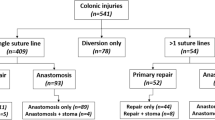Abstract
Background
There is limited evidence to suggest that the more distal a penetrating colonic injury, the poorer its expected outcome, prompting consideration of diversion rather than anastomosis when faced with left colonic injury. The clinical outcomes of penetrating colonic trauma in relation to their anatomical location within the colon were reviewed.
Methods
A review was performed over eight years (2012—2020) of all patients over 18 years who had sustained penetrating colon injury and presented to our trauma centre in South Africa. Direct comparison was made between right colon vs left colon injuries.
Results
A total of 450 patients were included; right colon: 260, left colon: 190. Gunshots predominated in the right colon, and the PATI was higher in this group. There were minimal differences in admission physiology and blood gas parameters between groups, but higher damage control surgery and ICU admission rates for the right colon group. There were similar rates of primary repair, anastomosis, and stoma between groups. Leak rates were no different between the two groups, and although overall complication rates were higher for the right colon, there was no difference with regard to gastro-intestinal and other complications, nor for mortality. While regression analysis did identify PATI to be a risk factor for overall complications and mortality, it failed to do so for anastomotic leak.
Conclusion
Our study did not demonstrate any difference in anastomotic leak rates or mortality between right vs left colonic injury. We recommend that all colonic injuries should be treated on their own merit, balanced against the patient’s condition, regardless of anatomical location within the colon.

Similar content being viewed by others
References
De Robles MS, Young CJ (2020) Outcomes of primary repair and anastomosis for traumatic colonic injuries in a tertiary trauma center. Medicina (Kaunas) 56(9):440. https://doi.org/10.3390/medicina56090440
Elfaedy O, Elgazwi K, Alsharif J, Mansor S (2020) Gunshot wounds to the colon: predictive risk factors for the development of postoperative complications, an experience of 172 cases in 4 years. ANZ J Surg 90(4):486–490. https://doi.org/10.1111/ans.15575
Cullinane DC, Jawa RS, Como JJ, Moore AE, Morris DS, Cheriyan J et al (2019) Management of penetrating intraperitoneal colon injuries: a meta-analysis and practice management guideline from the Eastern Association for the Surgery of Trauma. J Trauma Acute Care Surg 86:505–515. https://doi.org/10.1097/TA.0000000000002146
Dindo D, Demartines N, Clavien PA (2004) Classification of surgical complications: a new proposal with evaluation in a cohort of 6336 patients and results of a survey. Ann Surg 240(2):205–213. https://doi.org/10.1097/01.sla.0000133083.54934.ae
The American Association for the Surgery of Trauma. Trauma Tools. Injury Scoring Scale. https://www.aast.org/resources-detail/injury-scoring-scale#colon Accessed 2021.04.30.
Thompson JS, Moore EE, Moore JB (1981) Comparison of penetrating injuries of the right and left colon. Ann Surg 193(4):414–418. https://doi.org/10.1097/00000658-198104000-00004
Murray JA, Demetriades D, Colson M, Song Z, Velmahos GC, Cornwell EE 3rd et al (1999) Colonic resection in trauma: colostomy versus anastomosis. J Trauma 46(2):250–254. https://doi.org/10.1097/00005373-199902000-00009
Sharpe JP, Magnotti LJ, Weinberg JA, Zarzaur BL, Shahan CP, Parks NA et al (2012) Impact of location on outcome after penetrating colon injuries. J Trauma Acute Care Surg 73(6):1428–1432. https://doi.org/10.1097/TA.0b013e31825bff06
Fouda E, Emile S, Elfeki H, Youssef M, Ghanem A, Fikry AA, Elshobaky A, Omar W, Khafagy W, Morshed M (2016) Indications for and outcome of primary repair compared with faecal diversion in the management of traumatic colon injury. Colorectal Dis 18(8):O283–O291. https://doi.org/10.1111/codi.13421
Burlew CC, Moore EE, Cuschieri J, Jurkovich GJ, Codner P, Crowell K, Nirula R, Haan J, Rowell SE, Kato CM et al (2011) Sew it up! A Western Trauma Association multi-institutional study of enteric injury management in the postinjury open abdomen. J Trauma 70(2):273–277. https://doi.org/10.1097/TA.0b013e3182050eb7
Mansor S, Bendardaf R, Bougrara M, Hagam M (2014) Colon diversion versus primary colonic repair in gunshot abdomen with penetrating colon injury in Libyan revolution conflict 2011 (a single center experience). Int J Colorectal Dis 29(9):1137–1142. https://doi.org/10.1007/s00384-014-1918-7
Steele SR, Wolcott KE, Mullenix PS, Martin MJ, Sebesta JA, Azarow KS, Beekley AC (2007) Colon and rectal injuries during Operation Iraqi Freedom: are there any changing trends in management or outcome? Dis Colon Rectum 50(6):870–877. https://doi.org/10.1007/s10350-007-0235-4
Saar S, McPherson D, Nicol A, Edu S, Talving P, Navsaria P (2021) A contemporary prospective review of 205 consecutive patients with penetrating colon injuries. Injury 52(2):248–252. https://doi.org/10.1016/j.injury.2020.11.033
Oosthuizen GV, Kong VY, Estherhuizen T, Bruce JL, Laing GL, Odendaal JJ, Clarke DL (2018) The impact of mechanism on the management and outcome of penetrating colonic trauma. Ann R Coll Surg Engl 100(2):152–156. https://doi.org/10.1308/rcsann.2017.0147
Author information
Authors and Affiliations
Contributions
Oosthuizen GV is the Principal investigator. Buitendag J, Variawa S, and Čačala SR contributed to preparation and analysis of data, preparation of manuscript. Kong VY was involved in data analysis and manuscript preparation. Couch D contributed to data analysis, statistical analysis, manuscript preparation. Clarke DL is the Supervising author and was involved in data analysis, manuscript preparation.
Corresponding author
Ethics declarations
Conflict of interest
There are no conflicts of interest and no external funding was used for this study.
Additional information
Publisher's Note
Springer Nature remains neutral with regard to jurisdictional claims in published maps and institutional affiliations.
Rights and permissions
About this article
Cite this article
Oosthuizen, G.V., Čačala, S.R., Kong, V.Y. et al. Penetrating Colon Trauma—the Effect of Injury Location on Outcomes. World J Surg 46, 84–90 (2022). https://doi.org/10.1007/s00268-021-06312-z
Accepted:
Published:
Issue Date:
DOI: https://doi.org/10.1007/s00268-021-06312-z




